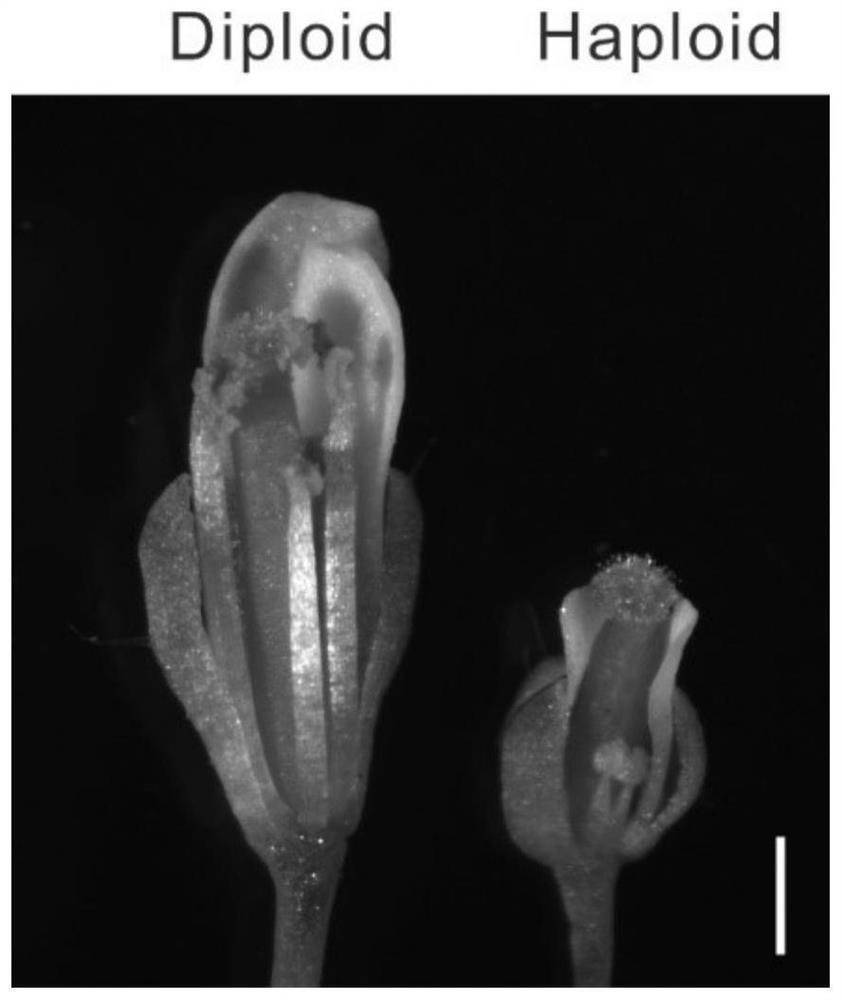Method for preparing angiosperm haploid from egg cell specific expression gene ECS and application of angiosperm haploid
A technology for expressing genes and angiosperms, applied in the field of biological breeding, can solve the problems of increasing the difficulty of screening male sterility phenotypes, affecting the seed setting rate, pollen development, germination or abnormal fertilization, etc., and achieve the effect of increasing the induction rate
- Summary
- Abstract
- Description
- Claims
- Application Information
AI Technical Summary
Problems solved by technology
Method used
Image
Examples
Embodiment 1
[0049] Example 1: Method for preparing angiosperm haploids by egg cell-specific expression gene ECS
[0050] (1) Identification of angiosperm ECS genes
[0051] Through NCBI homologous comparison of AtECS1 or AtECS2 protein sequences, the homologous proteins of ECS in angiosperms are analyzed. Through bioinformatics analysis, at least the following characteristics are met:
[0052] 1. The protein is annotated as aspartyl protease or probable / putativeaspartic protease in NCBI (National Center for Biotechnology Information);
[0053] 2. The protein sequence similarity with AtECS1 or AtECS2 is over 33%;
[0054] 3. Use SignalP-3.0 (https: / / services.healthtech.dtu.dk / service.php?SignalP-3.0) to analyze whether the protein has a signal peptide, and the N-terminus of the candidate protein has a signal peptide sequence;
[0055] 4. Through TMHMM-2.0 ( https: / / services.healthtech.dtu.dk / service.php?hl=en TMHMM- 2.0 ) to analyze its transmembrane structure, the candidate protein ...
Embodiment 2
[0069] Example 2: Application of the method for preparing angiosperm haploids by egg cell-specific expression gene ECS in the preparation of Arabidopsis haploids
[0070] (1) Obtain homozygous mutant of Arabidopsis ecs1 ecs2
[0071] 1. Obtaining ecs1 and ecs2 mutant seeds
[0072] The salk021086 (ecs1 ) and salk090795 (ecs2) mutant seeds were purchased from the SALK mutant repository (http: / / signal.salk.edu / ). Arabidopsis thaliana (Arabidopsis thaliana) Colombia ecotype is the mutant background and wild type material. Arabidopsis thaliana seeds were sterilized with 15% sodium hypochlorite solution for 5 minutes, rinsed with sterile water for 5 times, evenly placed on 1 / 2MS medium, and after vernalization for 2 days, they were placed in a light incubator at 22°C for 7 days ( 16 hours of light / 8 hours of darkness), transferred to the soil, and placed in an artificial greenhouse at 22°C±1°C for cultivation (16 hours of light / 8 hours of darkness). Primers for identifying mutants ...
PUM
 Login to View More
Login to View More Abstract
Description
Claims
Application Information
 Login to View More
Login to View More - R&D
- Intellectual Property
- Life Sciences
- Materials
- Tech Scout
- Unparalleled Data Quality
- Higher Quality Content
- 60% Fewer Hallucinations
Browse by: Latest US Patents, China's latest patents, Technical Efficacy Thesaurus, Application Domain, Technology Topic, Popular Technical Reports.
© 2025 PatSnap. All rights reserved.Legal|Privacy policy|Modern Slavery Act Transparency Statement|Sitemap|About US| Contact US: help@patsnap.com



